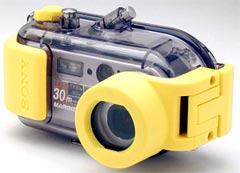The secret to using underwater cameras
To store beautiful images under the sea or swimming pool, the photographer needs to choose a specialized machine, the cover is under pressure and learns some lighting correction tips.
Use a cover to increase the pressure of the machine
Although the camera is water-resistant with a protective plastic cover, shooting under different depths is not easy. At a depth of 10 meters, the pressure around the machine is doubled compared to the water, making the buttons that release this pressure work hard. Therefore, users need to equip more cover to go deeper.
" Most manufacturers of water-resistant cameras offer specialized covers for many digital cameras for quite cheap prices, about $ 200, " said Stephen Frink, a world-leading photographer for underwater photography. , said. " It will support the device to dive to a depth of 40 meters ".

Shell Marine Pack for Sony's Cyber-shot.Photo: Imaging-resource .
Nikon since 1963 introduced the Nikono line which later became the standard for underwater shooting and they stopped producing this product in 1984 with the Nikono V. But after that, they still used the name Nikono for cover type for its Coolpix line. Sony also provided Marine Pack for Cyber-shot.
Select the appropriate camera
Earlier this year, Olympus and Pentax introduced a new underwater camera model. Olympus Stylus 770 SW has a 7.1 megapixel sensor, capturing below 10 meters of depth and a warning unit when it is too far away, priced at $ 380. Pentax 7-megapixel Optio A30 drops to a depth of 3 meters, priced at $ 300.
Vivitar's ViviCam 6200W also launched in March with a 6 megapixel sensor, which was captured at a depth of 10 meters, priced at $ 230. However, this device lacks the built-in flash.
Adjustment tips
Two points to be adjusted when shooting underwater are light and speed.
In terms of underwater lighting, flash can support the recovery of most natural colors, but the power and distance settings will be somewhat limited. Because the concentrated water molecules are 600 times more dense than air, the photographer needs very strong light to get a clear picture of the subject, even just 1 meter away from the machine. Therefore, it is recommended to use an external light source that is underwater lamps.
According to Frink, the shutter lag is the time between the shutter release and the camera actually recording the image. New point-and-shoot travel cameras all reduce this latency to the lowest level but still cannot be as fast as digital D-SLR interchangeable lenses. Therefore, if the fish swim too fast, the photographer needs to respond quickly to catch the most exciting moment.
Frink said that his secret is: If the image is not good, the photographer has not approached close enough.
 How to Survive Underwater in Minecraft, Breathe Underwater
How to Survive Underwater in Minecraft, Breathe Underwater Amazon submits the invention of an underwater warehouse to maximize storage space
Amazon submits the invention of an underwater warehouse to maximize storage space Surveillance camera: Should buy wired or Wi-Fi?
Surveillance camera: Should buy wired or Wi-Fi? How to shoot strange underwater portraits without getting a hair wet
How to shoot strange underwater portraits without getting a hair wet New technology underwater gliders predict high-precision storms
New technology underwater gliders predict high-precision storms